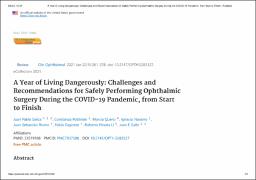| dc.contributor.author | Salica, Juan. | |
| dc.contributor.author | Potilinski, Constanza. | |
| dc.contributor.author | Querci, Marcia. | |
| dc.contributor.author | Et al. | |
| dc.date.accessioned | 2023-05-08T19:39:17Z | |
| dc.date.available | 2023-05-08T19:39:17Z | |
| dc.date.issued | 2021-01-15 | |
| dc.identifier.citation | Clin Ophthalmol . 2021 Jan 22;15:261-278 | es |
| dc.identifier.issn | 1177-5483 | |
| dc.identifier.uri | https://riu.austral.edu.ar/handle/123456789/2137 | |
| dc.identifier.uri | https://www.dovepress.com/a-year-of-living-dangerously-challenges-and-recommendations-for-safely-peer-reviewed-fulltext-article-OPTH | |
| dc.description | Disponible en: https://www.dovepress.com/a-year-of-living-dangerously-challenges-and-recommendations-for-safely-peer-reviewed-fulltext-article-OPTH | es |
| dc.description.abstract | Abstract
The COVID-19 pandemic has forced all nations to take an active role in infection control incorporating recommendations and measures to control viral dissemination. The epidemiological impact is very diverse and dynamic, even within the same region. Scientific knowledge regarding SARS-CoV-2 continues to improve every day with protocols needing to be updated and adjusted on a regular basis. Ophthalmology is a medical specialty identified to be at high risk for several reasons: it has very close doctor-patient contact, the virus has been detected in tears, and the ocular surface serves as a gateway to developing the infection. We have reviewed the current information on SARS-CoV-2 in the ophthalmologic field and provide up-to-date recommendations to help create protocols that can adapt to the dynamic situation of ophthalmologic institutions, patient cases, economic situations and access to diagnostic tests. This paper outlines the main recommendations regarding the initial consultation and outpatient clinics, measures to apply in the operating room (OR), and suggestions for post-surgical controls. Triage, according to the patient's conditions and eye pathology, reduction of the time the patient is at the institution, social distancing, correct use of personal protective equipment (PPE), barrier methods, hygiene, as well as other recommendations mentioned in this document, will allow physicians to take care of the visual health of the patients while reducing the impact of the COVID-19 pandemic.
Keywords: COVID-19; SARS-CoV-2; eye; ophthalmology; surgery.
© 2021 Salica et al. | es |
| dc.language.iso | en | es |
| dc.publisher | Taylor and Francis Group [Commercial Publisher] Dove Press [Imprint] | es |
| dc.rights | Attribution-NonCommercial-NoDerivatives 4.0 Internacional | * |
| dc.rights.uri | http://creativecommons.org/licenses/by-nc-nd/4.0/ | * |
| dc.subject | COVID-19. | es |
| dc.subject | SARS-CoV-2. | es |
| dc.subject | Ophthalmology. | es |
| dc.title | A Year of Living Dangerously: Challenges and Recommendations for Safely Performing Ophthalmic Surgery During the COVID-19 Pandemic, from Start to Finish | es |
| dc.type | Article | es |


